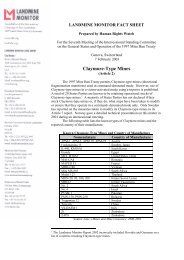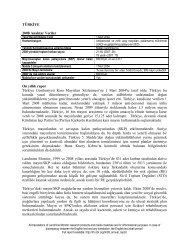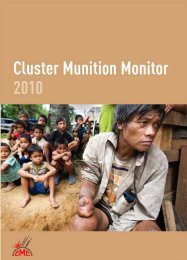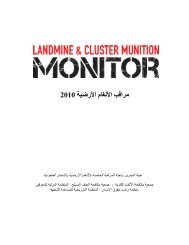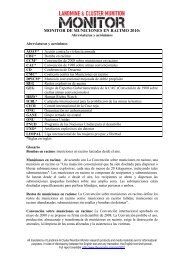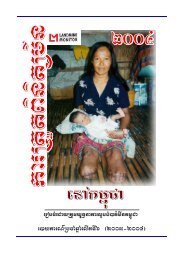Download PDF - Landmine and Cluster Munition Monitor
Download PDF - Landmine and Cluster Munition Monitor
Download PDF - Landmine and Cluster Munition Monitor
You also want an ePaper? Increase the reach of your titles
YUMPU automatically turns print PDFs into web optimized ePapers that Google loves.
Contamination <strong>and</strong> Clearance<br />
in Katanga province. 37 The scale of residual contamination from unexploded submunitions has not yet been<br />
quantified.<br />
• Iraq’s contamination from cluster munition remnants is not known with any degree of precision, but is<br />
believed to be very large. During the 1991 Gulf War, the highway between Kuwait <strong>and</strong> Basra was heavily<br />
targeted by cluster bomb strikes. 38 In northern Iraq (Iraqi Kurdistan), MAG has found cluster munition<br />
remnants from when Coalition forces launched cluster munition strikes around Dohuk in 1991. 39 <strong>Cluster</strong><br />
munitions were used extensively during the 2003 invasion of Iraq, particularly around Basra, Nasiriyah, <strong>and</strong><br />
the approaches to Baghdad. In 2004, Iraq’s National Mine Action Authority identified 2,200 sites of cluster<br />
munition contamination along the Tigris <strong>and</strong> Euphrates river valleys. 40 <strong>Cluster</strong> munition remnants are a feature<br />
of many of the clearance tasks being undertaken to open up access to oilfields, develop infrastructure <strong>and</strong><br />
for humanitarian clearance. 41 In 2010, a MAG survey of Dibis, northwest of Kirkuk, identified 20 previously<br />
unknown cluster munition strikes with contamination from unexploded BLU-97 <strong>and</strong> BLU-63 submunitions. 42<br />
Non-signatories<br />
Several of the 11 contaminated states that have not joined the convention have significant clearance programs in place,<br />
including Cambodia, Libya, Serbia, South Sudan, <strong>and</strong> Vietnam.<br />
• Cambodia, particularly its eastern <strong>and</strong> northeastern areas bordering Lao PDR <strong>and</strong> Vietnam, is affected by between<br />
1.9 million <strong>and</strong> 5.8 million cluster munition remnants. During the Vietnam War, the US dropped some<br />
26 million explosive submunitions in Cambodia. 43 In February 2011, Thail<strong>and</strong>’s use of cluster munitions in<br />
Cambodia’s northern province, Preah Vihear, resulted in additional submunition contamination. An assessment<br />
by the Cambodian Mine Action Center (CMAC) <strong>and</strong> NPA immediately after the shelling identified 12<br />
strike sites <strong>and</strong> contamination by unexploded submunitions over an area of approximately 1.5km 2 , impacting<br />
four villages <strong>and</strong> affecting between 5,000 <strong>and</strong> 10,000 people. 44 As of early July 2012, an ongoing nationwide<br />
Baseline Survey of mine <strong>and</strong> ERW contamination had identified 708 suspect areas in terms of cluster munitions<br />
covering an area of 327.4km 2 . 45<br />
• Libya was added to the list of contaminated states following use of cluster munitions by government forces<br />
in April 2011, but the precise extent of contamination from cluster munition remnants is not yet known. MAG<br />
conducted a rapid assessment of contamination in Misrata at the end of May 2011 <strong>and</strong> reported, “The presence<br />
of UXO <strong>and</strong> cluster munitions is extensive. … Conclusive evidence of cluster munition use was found at<br />
three sites, <strong>and</strong> the probability of finding additional contamination in other currently inaccessible areas of the<br />
city is very high.” 46 In June 2011, MAG reported that makeshift street “museums” in Misrata were displaying<br />
a large <strong>and</strong> dangerous range of munitions, including unexploded submunitions. 47 By March 2012, however,<br />
the Joint Mine Action Coordinating Team (JMACT) reported that all but one major street museum in Misrata<br />
had closed. 48<br />
• Serbia’s significant problem with cluster munition remnants dates from NATO air strikes in 1999, which hit<br />
16 municipalities across the country. 49 A survey initiated by NPA in 2010 is still in progress <strong>and</strong> as of June<br />
2012 had confirmed 165 hazardous areas totaling 11.85km 2 <strong>and</strong> identified 221 SHAs totaling some 5.73km 2 . 50<br />
On 29 April 2011, NPA initiated clearance operations in what was planned to be a three-year project. 51<br />
• In South Sudan, a total of 449 sites containing cluster munition remnants have been identified in nine states<br />
since 2006. As of July 2012, the number of uncleared sites stood at 52, of which 43 (more than 80%) are<br />
located in Western <strong>and</strong> Eastern Equatoria states. 52 <strong>Cluster</strong> munition remnants have been found in residential<br />
37<br />
Email from Charles Frisby, UNMACC, 21 April 2011.<br />
38<br />
UNICEF/UNDP, “Overview of <strong>L<strong>and</strong>mine</strong>s <strong>and</strong> Explosive Remnants of War in Iraq,” June 2009, p. 10.<br />
39<br />
Zana Kaka, “IRAQ: Saving lives of returnees in Dohuk,” MAG, 28 May 2010, www.maginternational.org.<br />
40<br />
<strong>L<strong>and</strong>mine</strong> Action, “Explosive remnants of war <strong>and</strong> mines other than anti-personnel mines,” London, March 2005, p. 86.<br />
41<br />
Telephone interview with Kent Paulusson, Senior Mine Action Advisor for Iraq, UNDP, 28 July 2011.<br />
42<br />
Cuts in funding resulted in MAG st<strong>and</strong>ing down these two teams in May 2011. Response to <strong>Monitor</strong> questionnaire by Mark Thompson,<br />
Country Programme Manager, MAG, 23 July 2011.<br />
43<br />
South East Asia Air Sortie Database, cited in Dave McCracken, “National Explosive Remnants of War Study, Cambodia,” NPA in collaboration<br />
with CMAA, Phnom Penh, March 2006, p. 15; Human Rights Watch, “<strong>Cluster</strong> <strong>Munition</strong>s in the Asia-Pacific Region,” April 2008; H<strong>and</strong>icap<br />
International (HI), Fatal Footprint: The Global Human Impact of <strong>Cluster</strong> <strong>Munition</strong>s (HI: Brussels, November 2006), p. 11.<br />
44<br />
Three kinds of submunitions were used: M42, M46, <strong>and</strong> M85. Aina Ostreng, “Norwegian People’s Aid clears cluster bombs after clash in<br />
Cambodia,” NPA, 19 May 2011. NPA said evidence in the area suggested about one in five of the submunitions had failed to detonate. Thomas<br />
Miller, “Banks tied to cluster bombs named,” Phnom Penh Post, 26 May 2011.<br />
45<br />
“BLS Statistics by L<strong>and</strong> Classification,” received by email from Eang Kamrang, Database Manager, Cambodia Mine Action <strong>and</strong> Victim<br />
Assistance Authority, Phnom Penh, 4 July 2012.<br />
46<br />
MAG, “Libya: Assessment mission shows need for urgent response in Misrata,” 1 June 2011.<br />
47<br />
MAG, “Libya: Remnants of conflict continue to pose huge threat to civilians,” 22 June 2011.<br />
48<br />
Email from Stefanie Carmichael, Communications Officer, JMACT, 20 March 2012.<br />
49<br />
Statement of Serbia, Mine Ban Treaty St<strong>and</strong>ing Committee on Mine Clearance, Mine Risk Education <strong>and</strong> Mine Action Technologies, Geneva,<br />
21 June 2011; <strong>and</strong> interview with Petar Mihajlović, Director, <strong>and</strong> Slađana Košutić, International Cooperation Advisor, SMAC, Belgrade, 25<br />
March 2011.<br />
50<br />
Interview with Slađana Košutić, SMAC, in Geneva, 23 May 2012.<br />
51<br />
Email from Vanessa Finson, NPA, 16 August 2011.<br />
52<br />
Response to <strong>Monitor</strong> questionnaire by Robert Thompson, Chief of Operations, UNMACC, 13 July 2012.<br />
45



